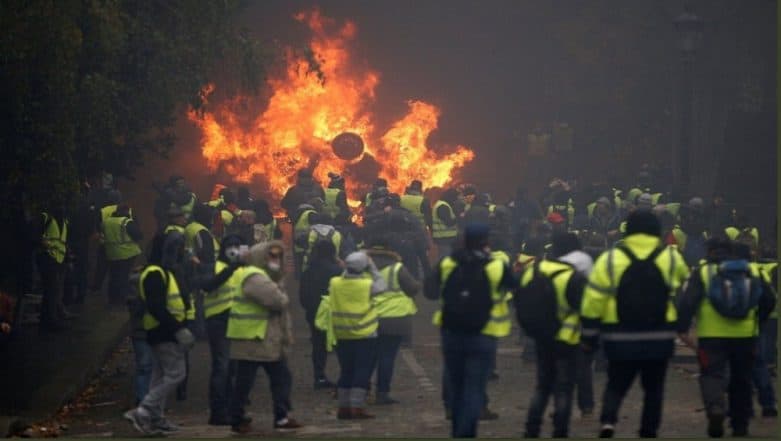France Protests: What Are The ‘Yellow Jacket’ Protesters Demanding From President Macron?
A day after hundreds of thousands of protesters laid siege to central Paris, President Emmanuel Macron has asked his prime minister to initiate talks with the protesting ‘gilets jaunes’ or ‘yellow jackets’.

A day after over hundreds of thousands of protesters laid siege to central Paris with hundreds injured, over four hundred arrested and vehicles and store fronts destroyed, President Emmanuel Macron has asked his prime minister to initiate talks with the protesting ‘gilets jaunes’ or ‘yellow jackets’.
Macron is yet to speak to the nation despite calls for him to offer immediate concessions to demonstrators, but government sources said the idea of imposing a state of emergency had not been discussed.
The French President however did visit the Arc de Triomphe, a global landmark which was targeted by the protesters. The inside of the historic monument was ransacked with the statue of Marianne, a symbol of the French Republic, smashed, and defaced.
Who are the Yellow Jackets?
Protesters began walking to the French capital about a week ago wearing neon-coloured vests. These vests are mandatory for vehicle owners to keep in their cars in case of roadside emergencies. The protesters began wearing these and walking along-side highways and roads as a sign of protest which led the safety jacket to be identified with their protests.
This protest was not organized by French labour unions which suggests it represents a “broader population” of the people. Almost eight in ten people in France support the “Yellow Jacket” protests, according to a poll published on Friday by the Figaro newspaper.
What do the Yellow Jackets want?
Political observers say at least some of those protesting belong to the “forgotten middle class” who are suffering from reforms being instituted by Emmanuel Macron.
They are especially angry about the tax increases and want the president to withdraw them. In France, an individual earning between $30,675 and $82,237 is taxed at 30 percent. In comparison an individual earning $30,675 in the U.S. would pay 12 percent in federal tax while someone earning $82,237 would pay 22 percent.
The middle-class hence feels squeezed by the government without seeing any improvement in their standard of life.
Starting January 1, 2019 the French government is also increasing tax on petrol which will go up by around 12 cents per gallon (approx. 4 litres) and on diesel by approximately 28 cents per gallon, according to Transport Minister Elisabeth Borne. Gas taxes will go up by another 5 cents per gallon by 2020, with diesel jumping an additional 2 cents.
These are not the first round of protests that Macron has seen within his first year as president. In May, attempts to reform France’s national railway brought huge crowds onto the roads and brought travel into and out of France, to a standstill. However, the current leaderless protests are being compared to the US Occupy movement with the protesters accusing Macron of focusing his policies on elites and businesses, slashing regulations while burdening the working class with increasing taxes on fossil fuels.
(The above story first appeared on LatestLY on Dec 03, 2018 06:24 AM IST. For more news and updates on politics, world, sports, entertainment and lifestyle, log on to our website latestly.com).



